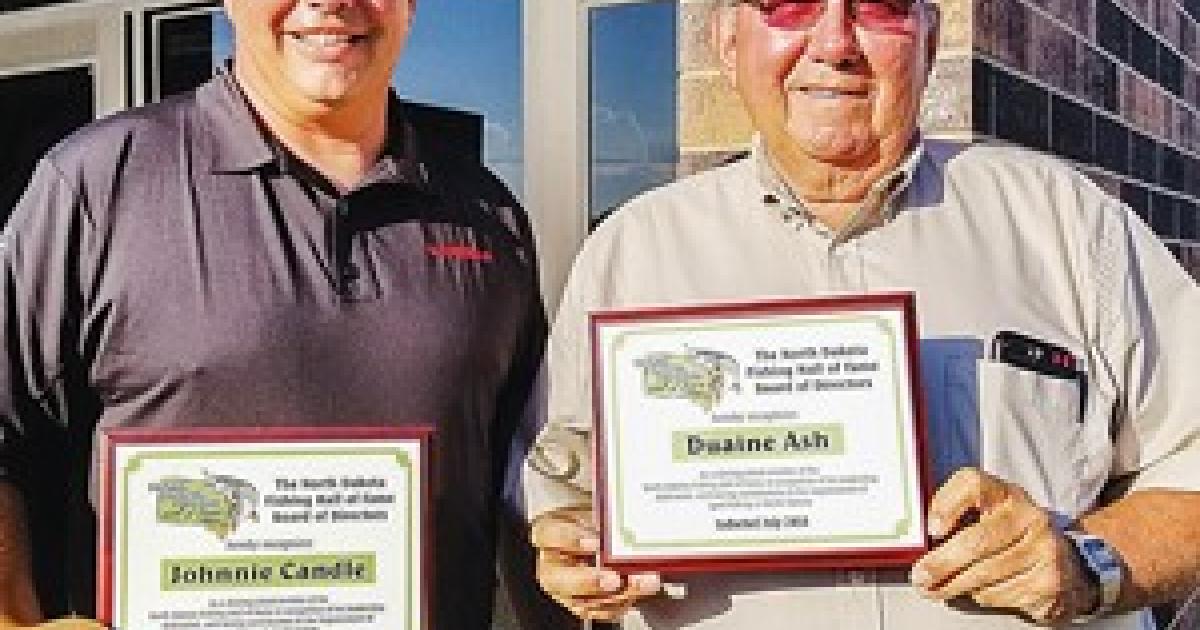From staff reports
For our annual ice fishing feature, North Dakota Living checks in again this winter with esteemed North Dakota fisherman, Duaine Ash, Devils Lake. Ash grew up on a farm near Underwood in McLean County (on McLean Electric Cooperative lines), and had a federal government career and National Guard service.
Photo courtesy of N.D. Game & Fish Dept.
The longtime Devils Lake resident has had a lifetime of fishing North Dakota waters, and has devoted his retirement time to fishing Devils Lake, year-round. The North Dakota Fishing Hall of Fame recently honored Ash; see page 7.
Like last year’s advice, Ash centers his message to folks sizing up ice fishing adventures on the importance of safety. That point is among these words of wisdom for 2019 ice fishing:
• Get local information on ice conditions. “What people should be doing, especially before they venture out – and for people that aren’t hard-core fisherman – check with the local bait shops and different people around the area to get the ice conditions,” he says. In particular, Ash warns about pressure ridges forming on frozen water, which indicate unsolid ice, which he says need to be respected.
• Ice hole drilling is a necessity, but not necessarily costly. “I have a K-drill and drills can be up in the $500 price range. But if you check around, and check bait shops, there are good used augers for about $100, which is good for beginners that just want to get out occasionally.” Ash uses radar and camera equipment, which can also be bought economically.
• Rattle, rattle. “For lures for ice fishing, I recommend using something with a rattle,” Ash says. He says using lighter line – 2-3 pound test – tends to improve results. But, equipment for lighter line is needed, to prevent line breaks.
• Move! “If you have been sitting at a spot for 15 minutes, and you’re not seeing any action or fish movement, then it’s time to move on to a different spot,” Ash says. He says he drives his truck out onto ice, so he can move when he needs to.
• Time = fish! Ash tells folks: “Time on the water is what produces fish. When they go out, they may not have success right away, but they should keep trying, and keep moving. The fish are there!”
Hall of Fame induction
Duaine Ash joined two other honorees for induction into the North Dakota Fishing Hall of Fame in 2018. Those additional honorees include: Johnnie Candle, Devils Lake, professional guide/fishing advocate; and Dakota Anglers, a Jamestown-based fishing club.
The mission of the North Dakota Fishing Hall of Fame is to conduct and maintain a program to recognize and honor those persons, organizations, or institutions that have made significant and lasting contributions to sportfishing in North Dakota.
In honoring Duaine Ash, the tribute the N.D. Fishing Hall of fame to him read in part:
“Duaine’s leadership and efforts have been invaluable to sportfishing in North Dakota. He has always displayed an unselfish dedication to help and educate others, positively promote sportfishing, and preserve and protect the fishery resources.”
Ice fishing prospect reports
In its annual report of fish populations and prospects for the ice fishing season, the N.D. Department of Game & Fish provides status report briefings regarding nearly 80 rural lakes and waterways.
The following is a small sampling of those current ice fishing prospect reports, published in the November 2018 issue of North Dakota Outdoors, the monthly magazine from N.D. Game & Fish. To see the full ice fishing prospects report, see North Dakota Outdoors at: https://gf.nd.gov/(link is external).
SOUTH CENTRAL FISHERIES DISTRICT
• Alkaline Lake (Kidder County) – Walleye abundant. Excellent pike numbers, with fish occasionally surpassing 10 pounds. Large perch in low numbers.
• Harmon Lake (Morton County) – Bluegill, crappie and largemouth bass abundant. Rainbow trout and pike present in low numbers.
• West Lake Napoleon (Logan County) – Pike abundant and a fair number of perch present.
NORTHEAST FISHERIES DISTRICT
• Carpenter Lake (Rolette County) – Consistent pike population, with most fish about 24 inches, with some larger fish.
• Homme Dam (Walsh County) – High density perch population, with a decent number of fish longer than 8 inches. Should provide lots of action.
• Heaton Slough Complex (Wells County) – Two different water bodies, with some nice perch and pike from 3-10 pounds.
SOUTHEAST FISHERIES DISTRICT
• Grass Lake (Sargent County) – Great crappie numbers, with fish averaging about 12 inches. Some large walleye consistently sampled during recent netting surveys.
• Island Lake (Barnes County) – Contains a high-density walleye population, with fish averaging nearly 2.5 pounds. Fish exceeding 25 inches have become increasingly common.
SOUTHWEST FISHERIES DISTRICT
• Dickinson Reservoir (Stark County) – Good number of walleyes up to 6 pounds, good number of bluegill up to 1.5 pounds, good number of pike up to 14 pounds, good number of perch up to 1 pound and some crappie.
• Heart Butte Reservoir (Grant County) – An abundance of mostly small walleye, with some fish up to 5 pounds, pike up to 9 pounds, white bass up to 2 pounds, crappie up to 1 pound, good number of perch up to 1 pound and some bluegill up to a half-pound.
NORTHWEST FISHERIES DISTRICT
• Cottonwood Lake (Williams County) – Good northern pike fishery, with a variety of sizes. Abundant small yellow perch and some eater-sized walleye.
• Northgate Dam (Adams County) – Good bluegill and walleye populations. Fair number of black crappie and rainbow trout stocked annually.
Ice safety is priority
Before going onto a frozen lake, pond or river, the N.D. Game and Fish Department says it’s important to take safety precautions to reduce the risk of falling through the ice.
Knowing how to judge ice conditions will also help you make more informed decisions while enjoying your outing.
Remember: You take a risk anytime you go onto the ice. Ice thickness is not consistent.
Look for clear, blue ice. New ice is stronger than old ice.
Beware of ice around partially submerged objects such as trees, brush, embankments or structures.
Ice will not form as quickly where water is shallow or where objects may absorb sunlight.
When ice fishing, it is always a good idea to drill test holes or use an ice chisel as you venture onto a lake, to help judge the thickness and character of the ice.
Ice thickness and safety guidelines/general rules of thumb:
• 2 inches – STAY OFF
• 4 inches of good ice supports a walking individual
• 6 inches of good ice supports a snowmobile or ATV
• 8-12 inches of good ice supports a car or small pickup
• 12-15 inches of good ice supports a medium pickup
Source: N.D. Department of Game & Fish











